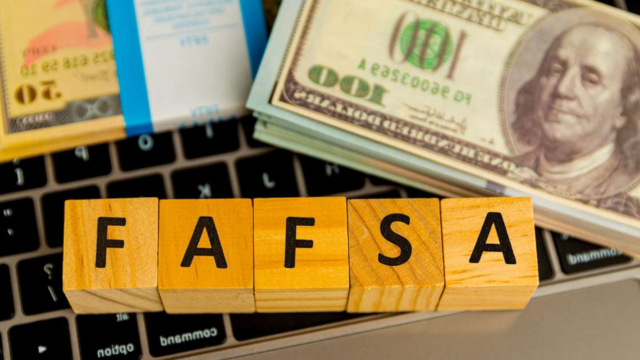FAFSA Simplified: Filling out the Free Application for Federal Student Aid (FAFSA) is one of the most important things you can do to get money for college. Whether you’re applying to a four-year college, a community college, or a vocational school, filling out the FAFSA gives you access to a wide range of financial aid options, such as federal grants, loans, and work-study programs.
You need to fill out the FAFSA form if you want to go to college in the 2025–26 school year. But now it’s easier than ever to do. The FAFSA Simplification Act has made big changes to the application, which makes it easier and faster to fill out. Here’s what you need to know about the new process to make the most of your financial help and make sure your application goes smoothly.
FAFSA Simplified
| Topic | Details |
|---|---|
| What is FAFSA? | A form to apply for financial aid for college, including federal grants, loans, and work-study opportunities. |
| Application Deadlines | The 2025–26 FAFSA opened on November 21, 2024. Check state and school-specific deadlines for earlier cutoff dates. |
| Changes in the FAFSA | The new FAFSA form has been streamlined, reducing the number of questions from 100+ to 36. It is now quicker and easier to fill out. |
| IRS Data Retrieval Tool | Automatically imports tax data into the form, reducing errors and speeding up processing. |
| What Aid You Can Get | Federal Pell Grants, federal student loans, state aid, school-specific scholarships, and work-study programs. |
| Official Resource | Visit the official FAFSA website for more information. |
Filling out the FAFSA is a must if you want to get the college financial help you need. The FAFSA process for 2025–26 is now easier, faster, and more user-friendly because of the FAFSA Simplification Act. To make sure your application is as correct as it can be, follow the steps in this guide and use tools like the IRS Data Retrieval Tool.
Introduction to the FAFSA Simplification Act
Once it became law in 2024, the FAFSA Simplification Act aimed to make the process of getting financial help easier for families. Now that these changes have been made, the FAFSA application form is easier for all students to fill out and requires less paperwork. These changes will be reflected for the first time on the 2025–26 FAFSA. Understanding these changes is important for getting the most financial help possible.
This guide will go over the most important changes, give you useful tips on how to fill out the form, and give you ideas on how to get the most out of your help for the next school year.
What’s Different About FAFSA in 2025–2026?
It hasn’t always been easy to understand the FAFSA process, but it has always been necessary to get financial help. The form was too hard to understand and took too much time for many families. Here are the main changes that have been made to the 2025–26 FAFSA to make it easy to fill out:
1. Fewer Questions
The new FAFSA has 36 questions instead of over 100, which makes it much easier to fill out. With this change, you won’t have to answer any more difficult questions about things like home equity, which were hard to understand.
2. Tax information sent automatically
In previous years, families had to enter information from their tax forms by hand. Right now, the IRS Data Retrieval Tool gets tax information straight from the IRS. It’s less likely that mistakes will happen because this feature makes the process more accurate and saves you time.
3. Making it easier to figure out family contributions
In the past, families and students had to figure out how much they could afford to pay for college. Instead, the Student Aid Index (SAI) was put in place, which is easier to understand and more fair. The SAI looks at your income and family situation to decide how much financial help you can get.
4. More people can now get the Pell Grant
More students should be able to get Pell Grants now that the FAFSA is easier to fill out. These grants are given to students with low incomes and don’t need to be paid back, so they’re helpful for anyone who is qualified.
5. The FAFSA will be available earlier
Early this year, on November 21, 2024, the FAFSA began for the 2025–26 school year. This gives kids and their families more time to fill out the application and look into other ways to get money, like state grants and school-based scholarships.
Discover how to get the most out of your FAFSA aid for the 2025–26 school year.
With the changes to FAFSA, it’s now easier than ever to get financial help. However, there are a few important steps you should take to make sure you get all the financial help you’re eligible for:
Step 1: Get the Paperwork You Need
Make sure you have all of the following things before you start the FAFSA:
- Tax Returns: The most recent tax returns. For example, you will need your tax return from 2023 for the 2025–26 FAFSA.
- With W-2 forms, you can see how much money you made from work.
- Payment History: You need to give details about your savings and cash accounts.
- Number: The student and, if necessary, the parent need to have their SSNs.
- You’ll need to make an FSA ID account in order to online sign the FAFSA. Each parent and student needs their own FSA ID.
Getting all of these papers together ahead of time will speed up the process and make sure you don’t overlook any important details.
Step 2: Fill out the FAFSA online.
You can now fill out the FAFSA online at the official FAFSA website. These are the most important steps to take:
- Use your FSA ID to log in: If you don’t already have one, you’ll need to make one. This ID is needed to online sign the form.
- Please answer the questions: The new FAFSA is much easier to use as it only has 36 questions. Just be sure to carefully follow the directions.
- Use the IRS Data Retrieval Tool: This tool will automatically import your tax information from the IRS, which will make the process go faster and lower the chance of making mistakes.
- Look over your information: Check all the information you’ve entered twice to make sure it’s right before you submit.
- Put in your FAFSA: Once you’re sure of everything, send it in and keep the confirmation number for your notes.
Step 3: Keep an eye on your Student Aid Report (SAR).
You’ll get a Student Aid Report (SAR) after you send in your FAFSA. This report includes your Student Aid Index (SAI) and an overview of the information you sent in. Check it carefully to make sure it’s right. You can make changes to your FAFSA account if there are any mistakes.
Step 4: Fill out more applications for grants and scholarships.
Aside from the government aid you can get through FAFSA, you should also look for other types of aid, like state grants and school-specific scholarships. Here are a few ways to get more money:
- State Grants: Different states have different rules about how to apply for grants, so make sure you know what the rules are in your state.
- Scholarships based on merit: Many schools give scholarships to students who do well in school. Find out about grants and how to apply by going to the financial aid office at your school.
- Private Scholarships: A lot of businesses, groups, and foundations give scholarships to students. You can find chances on websites like Scholarships.com and Fastweb.
Step 5: Take charge of your deadlines.
The federal deadline for the FAFSA is June 30, 2026, but many states and schools have their own dates. Do the right thing and send in your FAFSA early, because some help programs have limited funds and give it to the first person who applies. For exact dates, check with the financial aid office at your school.





More Stories
FAFSA Simplified: How to Maximize Your Aid for the 2025–26 School Year
FAFSA Simplified: How to Maximize Your Aid for the 2025–26 School Year
FAFSA Simplified: How to Maximize Your Aid for the 2025–26 School Year